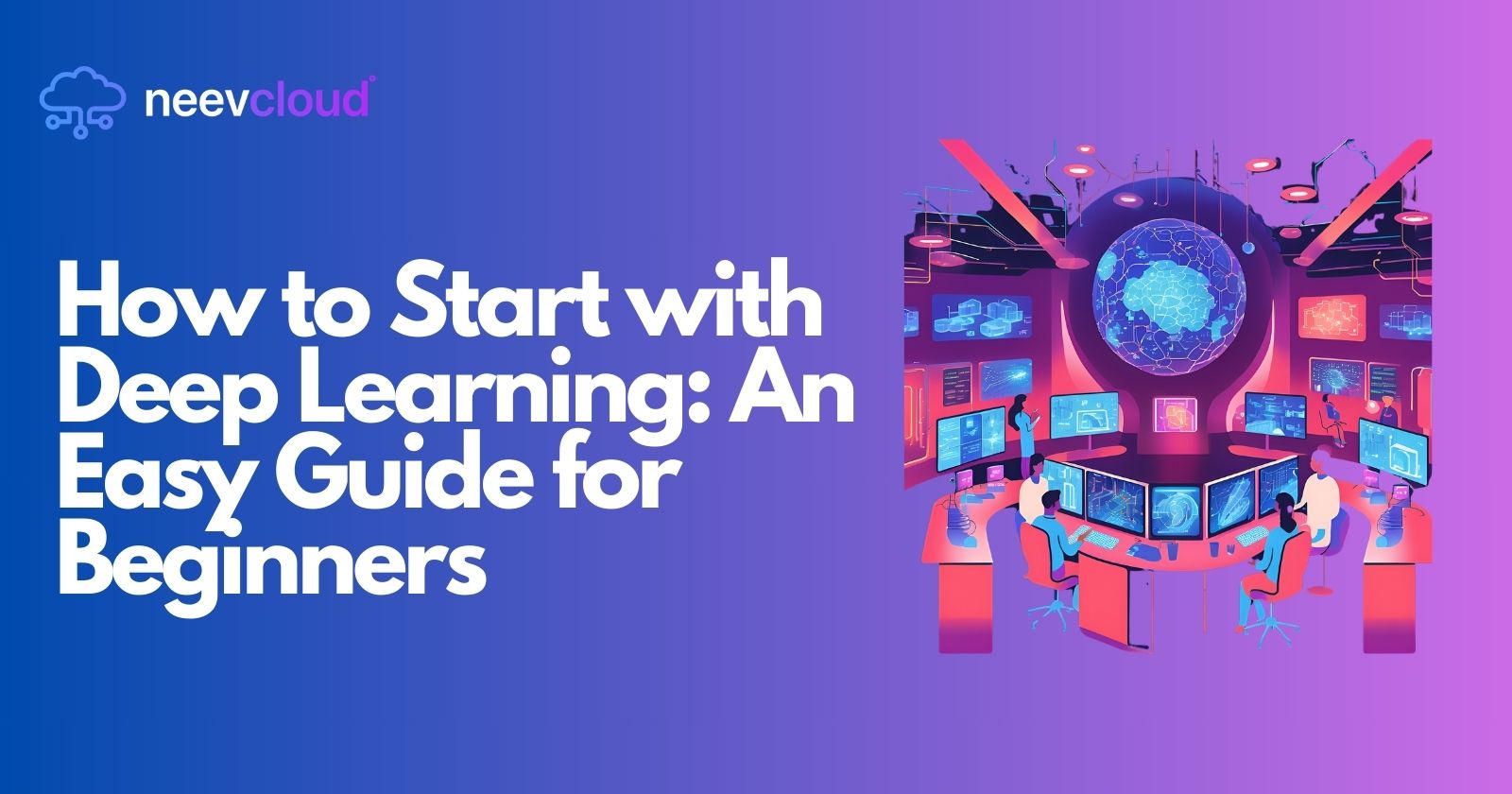How to Start with Deep Learning: An Easy Guide for Beginners
 Tanvi Ausare
Tanvi Ausare
Deep learning has emerged as a revolutionary subset of machine learning, unlocking capabilities that were once confined to the realm of science fiction. From autonomous vehicles and virtual assistants to personalized recommendations and medical imaging, deep learning is the backbone of cutting-edge AI technologies. In this blog, we’ll dive deep into what deep learning is, how it works, and how you can get started with it. Along the way, we’ll explore the role of AI Cloud, deep learning networks, and AI Datacenters in this fascinating journey.
What is Deep Learning?
Deep learning is a branch of artificial intelligence (AI) that mimics the way humans learn. It uses artificial neural networks structured in layers to process vast amounts of data and identify patterns. Unlike traditional machine learning algorithms, deep learning excels at handling unstructured data like images, text, and audio, making it indispensable for tasks requiring high precision and automation.
Key Characteristics of Deep Learning:
Multi-layered Architecture: Deep learning models consist of multiple layers of neurons that enable complex feature extraction.
High Data Dependency: The more data you feed a deep learning model, the better its accuracy.
Self-learning Capabilities: These systems learn directly from data without the need for explicit feature engineering.
Scalability: Deep learning models are scalable and thrive in environments with powerful hardware like GPUs and AI Clouds.
How Does Deep Learning Work?
At the heart of deep learning lies the artificial neural network, inspired by the human brain. These networks consist of layers of neurons connected by weights that adjust during training to improve predictions.
Steps in Deep Learning Workflow:
Data Collection:
Acquire large datasets relevant to your problem.
Examples include labeled images for computer vision or text data for natural language processing.
Data Preprocessing:
Normalize, clean, and transform the data into a format suitable for training.
Techniques include resizing images, removing noise, and tokenizing text.
Model Selection:
Choose a deep learning architecture based on your use case, such as:
Convolutional Neural Networks (CNNs) for image recognition.
Recurrent Neural Networks (RNNs) for sequential data like time series.
Transformer-based models for natural language processing.
Training the Model:
Feed data into the model, allowing it to adjust weights and biases through backpropagation.
Utilize frameworks like TensorFlow or PyTorch for implementation.
Evaluation and Fine-tuning:
Evaluate model performance using validation datasets.
Optimize hyperparameters to improve accuracy.
Deployment:
- Deploy the model in production using AI Cloud solutions or dedicated AI Datacenters.
Deep Learning Networks: Core Architectures
Deep learning networks are designed to address specific problems effectively. Let’s explore some core architectures:
Convolutional Neural Networks (CNNs):
Primarily used for image recognition and classification.
Excels in tasks like object detection, facial recognition, and medical image analysis.
Recurrent Neural Networks (RNNs):
Designed for processing sequential data.
Ideal for time-series analysis, language translation, and speech recognition.
Generative Adversarial Networks (GANs):
Comprise two neural networks: a generator and a discriminator.
Used for generating realistic images, videos, and even synthetic data.
Transformer Models:
Widely adopted in natural language processing tasks.
Popular frameworks include BERT, GPT, and Llama 2.
The Role of AI Cloud in Deep Learning
The AI Cloud plays a pivotal role in accelerating deep learning projects by providing scalable infrastructure and tools.
Advantages of Using AI Cloud for Deep Learning:
High Compute Power: Access to GPUs and TPUs to train models faster.
Collaboration-Friendly: Easy sharing of resources and collaborative development.
Cost Optimization: Pay for resources you use, avoiding upfront hardware investments.
Scalability: Scale up or down depending on project requirements.
Ease of Deployment: Seamlessly deploy models into production environments.
Why AI Datacenters are Essential for Deep Learning
AI Datacenters provide the backbone infrastructure for intensive deep learning workloads. They house GPUs, AI accelerators, and storage solutions tailored for AI operations.
Key Features of AI Datacenters for Deep Learning:
Dedicated Hardware: Specialized GPUs like NVIDIA A100 or H100 optimize model training and inference.
High Throughput Storage: Ensures rapid access to large datasets.
Advanced Cooling Systems: Keeps hardware at optimal temperatures during peak loads.
Secure Environments: Protects sensitive AI models and datasets from breaches.
How to Get Started with Deep Learning
Beginning your deep learning journey can seem daunting, but a structured approach simplifies the process.
Step 1: Learn the Basics
Familiarize yourself with the foundational concepts of AI and machine learning.
Understand terms like neural networks, backpropagation, and activation functions.
Step 2: Pick the Right Tools and Frameworks
Popular frameworks include:
TensorFlow: Great for both beginners and advanced users.
PyTorch: Known for flexibility and ease of debugging.
Keras: Simplifies building and training neural networks.
Step 3: Choose an AI Cloud Platform
- Select a cloud service like NeevCloud that supports AI workloads with pre-configured environments, GPU instances, and integrated development tools.
Step 4: Work on Projects
Start small with projects like image classification or sentiment analysis.
Gradually move to more complex tasks like creating GANs or deploying transformers.
Step 5: Leverage Online Resources
Use tutorials, online courses, and documentation to enhance your skills.
Participate in forums and communities to solve problems collaboratively.
Common Challenges in Deep Learning
Like any advanced technology, deep learning comes with its own set of challenges.
Challenges:
Data Scarcity: High-quality datasets are critical but often hard to find.
Compute Resources: Training deep learning models requires significant computational power.
Model Interpretability: Neural networks can act as "black boxes," making their decisions hard to interpret.
Overfitting: Models may perform well on training data but fail in real-world scenarios.
Solutions:
Use data augmentation techniques to expand your datasets.
Utilize AI Datacenters and AI Cloud platforms for scalable resources.
Apply techniques like LIME or SHAP to interpret models.
Regularize models using dropout or L2 regularization to avoid overfitting.
Future of Deep Learning
The future of deep learning is promising, with advancements in AI hardware, algorithms, and applications. Key trends include:
Edge AI: Running deep learning models on edge devices for real-time decision-making.
Federated Learning: Training models collaboratively without sharing data.
Neuro-symbolic AI: Combining symbolic reasoning with neural networks.
Hyper-optimized Hardware: GPUs and accelerators specifically designed for deep learning, such as NVIDIA H100.
Conclusion
Deep learning is transforming industries by enabling smarter, faster, and more precise AI solutions. Whether you’re a researcher, developer, or enthusiast, understanding its foundations and leveraging tools like AI Cloud and AI Datacenters is the first step toward mastering this powerful technology.
At NeevCloud, we provide the infrastructure and expertise needed to accelerate your deep learning projects. From pre-configured deep learning environments to cutting-edge GPUs, we empower innovators to bring their ideas to life.
Start your deep learning journey today with NeevCloud and unlock the limitless potential of AI!
Subscribe to my newsletter
Read articles from Tanvi Ausare directly inside your inbox. Subscribe to the newsletter, and don't miss out.
Written by
